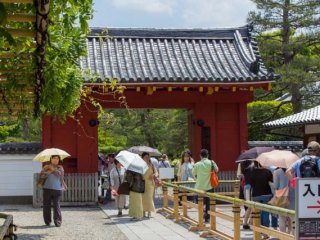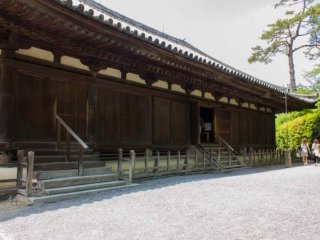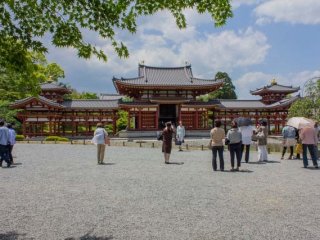Since March of this year, the Phoenix Hall of Byōdō-in, was once again visible. For the past two years it was covered in scaffolding because of renovation. There is still a small part in the back that is still undergoing construction though. This fall the work should be completed. The famous Phoenix Hall is the main attraction and inside is a statue of Amitabha Tathagata, by the renowned sculptor Jōchō. It dates back to 1053 and is made of wood covered with gold leaf, reaching a height of almost 3 meters. You can still see the Raigō paintings on the wooden doors of the Phoenix Hall, depicting the Descent of the Amida Buddha. They were painted by Tamenari Takuma.
- 1 min read
The Phoenix Hall of Byōdō-in
A World Heritage Site in Uji City, Kyoto

Community writer
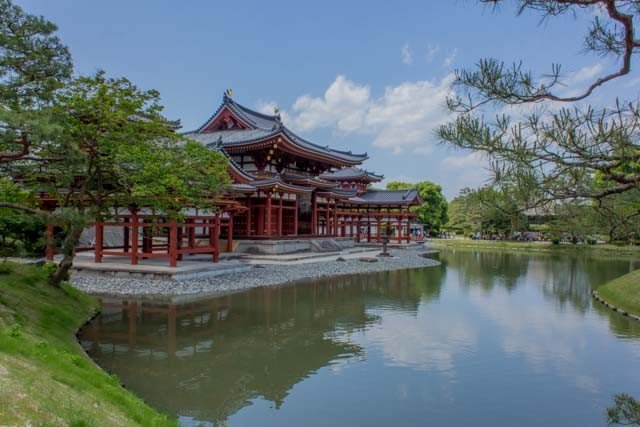
The many different faces of the Phoenix Hall (鳳凰堂) of Byōdō-in (平等院): A World heritage Site in Uji City, Kyoto. If you look closer, in the center of the Phoenix Hall you can still see one of the Raigō paintings on the wooden door of the Phoenix Hall, depicting the Descent of the Amida Buddha. They were painted by Tamenari Takuma in the 11th century. They are an early example of Yamato-e, Japanese-style painting, and contain representations of the scenery around Kyoto.of the 11th century
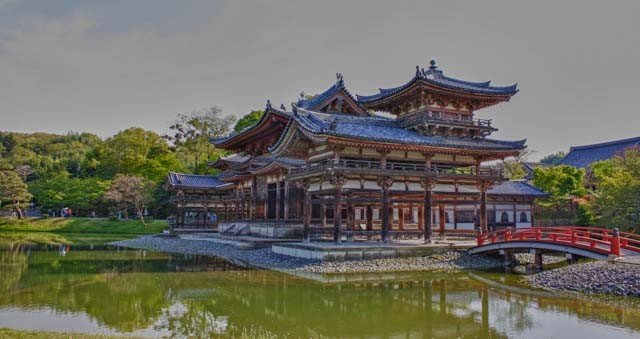
This is the Phoenix Hall (鳳凰堂) in April 2009, when I first visited Byōdō-in (平等院) in Uji City. This is a HDR version

The Omote-mon gate (表門) of the Byōdō-in (平等院) in Uji City, Kyoto. This is the main gate to the temple grounds from the Byodoin Omote-sando (shopping street)

This is a memorial stone to Minamoto no Yorimasa (源 頼政-1106–1180), head of the Genji clan who fought in Uji against the powerful Heike family. He lost against Taira no Kiyomori (平 清盛-1118 – March 20, 1181) and committed suicide by seppuku at the Byodo-in temple while reciting waka poems. Every year, on May 26, a memorial service is held here to commemorate this historical event

Frontal view of the Kannon-do (観音堂) of Byōdō-in (平等院) in Uji City, Kyoto. Inside is a statue of Rengeshu Bosatsu (Avalokiteśvara) from the Heian period

The Phoenix Hall (鳳凰堂) of Byōdō-in, a popular spot to have your picture taken

Inside the Chudo of the Phoenix Hall is a statue of Amitabha Tathagata (阿弥陀如来), dating back to the Heian Period. This statue was carved by Jōchō (定朝) in 1053 and is made of wood covered with gold leaf, reaching a height of almost 3 meters

Ryūzu Gawara (龍頭瓦) Dragon Head Tile on the roof of Ho'o-do of the Byōdō-in (平等院) in Uji City, Kyoto. There is a legend about these “Dragon Head tiles”. Uji is compared to a great dragon’s palace, and the Uji River, which flows through it, is where the founder of Byōdō-in, Fujiwara Yorimichi, watches over his masterpiece as a dragon god. Dragons also come out quite often in Buddhist teachings as creatures which uphold Buddhist law. Dragons also are featured alongside snakes - which are symbols of fertility - in much folklore and legends in Japan

If you want to take a little break, you can take a rest in this small pavilion and enjoy the scenery of Byōdō-in (平等院) in Uji City, Kyoto

Buddhist figure on a boat in front of the Hondo of Jodo-in (浄土院) of Byōdō-in (平等院) in Uji City, Kyoto

The Hondo of Jodo-in (浄土院) of Byōdō-in (平等院) in Uji City, Kyoto. After passing through the Nan-mon (南門) or south gate, the Jodo-in is on your left side

Inside the Rakan-do (羅漢堂) are wooden sculptors of Chashi Hoshino Dōsai(茶師 星野道斎) and his disciples. The Rakan-do was established in 1614. A Chashi is a master tea connoisseur in the art of selecting and blending tea

The Nan-mon (南門) or south gate of the Byōdō-in (平等院) in Uji City, Kyoto

Fujidana Wisteria Trellis (藤棚) in the precincts of Byōdō-in (平等院) in Uji City, Kyoto. I was a little late to see its flowers, I did hear though that it is quite impressive. This wisteria tree is believed to be around 250 years old and blooms from late April to early May. This is a Golden Week favorite for many
Leave a comment
0 comments in total
Book your trip
Find a nearby hotel
Explore some of the best nearby hotels and deals for the perfect place to stay in Japan.
Top Articles
-
![Exploring Japan Through the Seasons: Three First-Time Classic Tours Exploring Japan Through the Seasons: Three First-Time Classic Tours]() 1
1Exploring Japan Through the Seasons: Three First-Time Classic Tours
Culture -
![An Intellectual Journey Through Fujita Tsuguharu’s Legacy in Akita An Intellectual Journey Through Fujita Tsuguharu’s Legacy in Akita]() 2
2An Intellectual Journey Through Fujita Tsuguharu’s Legacy in Akita
Akita - Sponsored -
![Miyoko Schinner: Japan Vegan Tour 2026 Miyoko Schinner: Japan Vegan Tour 2026]() 3
3Miyoko Schinner: Japan Vegan Tour 2026
Food -
![A Taste of Shiga at COCOSHIGA A Taste of Shiga at COCOSHIGA]() 4
4A Taste of Shiga at COCOSHIGA
Tokyo - Sponsored -
![See Southern Japan with Kirishima As Your Gateway See Southern Japan with Kirishima As Your Gateway]() 5
5See Southern Japan with Kirishima As Your Gateway
Kagoshima - Sponsored -
![A Journey Through Western Kyushu A Journey Through Western Kyushu]() 6
6A Journey Through Western Kyushu
Nagasaki - Sponsored -
![Japan Pottery Tour: Hands-On Workshops & Artisan Encounters Japan Pottery Tour: Hands-On Workshops & Artisan Encounters]() 7
7Japan Pottery Tour: Hands-On Workshops & Artisan Encounters
Culture -
![A Hidden Getaway in Yaizu, Shizuoka A Hidden Getaway in Yaizu, Shizuoka]() 8
8A Hidden Getaway in Yaizu, Shizuoka
Shizuoka - Sponsored -
![Ultimate Japan Car Culture Journey - From Auto Salon 2026 to the Open Road Ultimate Japan Car Culture Journey - From Auto Salon 2026 to the Open Road]() 9
9Ultimate Japan Car Culture Journey - From Auto Salon 2026 to the Open Road
Chiba -
![An Immersive Look Into Akita’s Food Heritage An Immersive Look Into Akita’s Food Heritage]() 10
10An Immersive Look Into Akita’s Food Heritage
Akita - Sponsored
-
![Tokyo Christmas Market Tokyo Christmas Market]() 1
1Tokyo Christmas Market
Tokyo -
![Guide to Bringing Medicines Into Japan Guide to Bringing Medicines Into Japan]() 2
2Guide to Bringing Medicines Into Japan
Planning -
![The Ultimate Guide to Thrifting in Tokyo The Ultimate Guide to Thrifting in Tokyo]() 3
3The Ultimate Guide to Thrifting in Tokyo
Shopping -
![Shibuya Blue Cave Illumination Shibuya Blue Cave Illumination]() 4
4Shibuya Blue Cave Illumination
Tokyo -
![Your Name: Real-Life Locations in Tokyo Your Name: Real-Life Locations in Tokyo]() 5
5Your Name: Real-Life Locations in Tokyo
Tokyo -
![Nabana no Sato Illumination Nabana no Sato Illumination]() 6
6Nabana no Sato Illumination
Mie -
![Winter in Japan: Your Seasonal Guide Winter in Japan: Your Seasonal Guide]() 7
7Winter in Japan: Your Seasonal Guide
Planning -
![Bad Bunny Debí Tirar Más Fotos World Tour Bad Bunny Debí Tirar Más Fotos World Tour]() 8
8Bad Bunny Debí Tirar Más Fotos World Tour
Tokyo -
![January Grand Sumo Tournament (Tokyo) January Grand Sumo Tournament (Tokyo)]() 9
9January Grand Sumo Tournament (Tokyo)
Tokyo -
![Tokyo Auto Salon Tokyo Auto Salon]() 10
10Tokyo Auto Salon
Chiba


